#sacredmarriage
Text

In most versions of the Sophia mythos the fall of the Goddess is intimately linked to the activity of another Aeon, Christos, also named for its flow-signature, "anointing power." In cosmic terms anointing is the capacity of an Aeon to morph from a porous, foamlike state into a fluidic, dewlike state. Foam is not dew, but imagine foam turning to dew. That is anointing in the Pleromic domain. The product of anointing, chrism, is the love sweat of the gods. In the ecstasy of their dancing the Aeons break into a fragrant sweat, a bright, dewy eruption. This is anointing at the cosmic level.

Astrophysicists now accept the presence of "molecular dew" in the galactic arms though not yet at the galactic core, and they are reticent to assume it can have biological properties. Theorists of steady-state plasma cosmology may be approaching a recognition of the foamlike, high-density, low-mass porosity of Aeonic currents. Plasma cosmology is currently the best alternative to the big bang fantasia. In Tantric and Gnostic cosmology alike there is far more foreplay than hard-core, orgasmic sex. This certainly applies to the orgiastic cavorting of the Aeons in the Pleroma.

The hieros gamos (sacred mating) of Sophia and Christos in the core region of our galaxy signals the opening event of the Sophia mythos. Between them they shape or configure the singularity offered by the Originator. The Greek word anthropos means "humanity," or more precisely, "the human template." Anthropos is gender-neutral, distinct from the gender-specific words andros, "male" and gyne, "female." Anthropos is the Gnostic name for the cosmic matrix of the human species, the preterrestrial human genome. The Sophia mythos assumes a version of "directed panspermia," the theory introduced by Nobel Prize-winning Swedish chemist Svante Arrhenius around 1900 and accepted, in various forms, by astronomer Fred Hoyle, Nobel biologist Francis Crick (codiscoverer with James Watson of the structure of DNA), Lynn Margulis, and many other leading minds of our time.
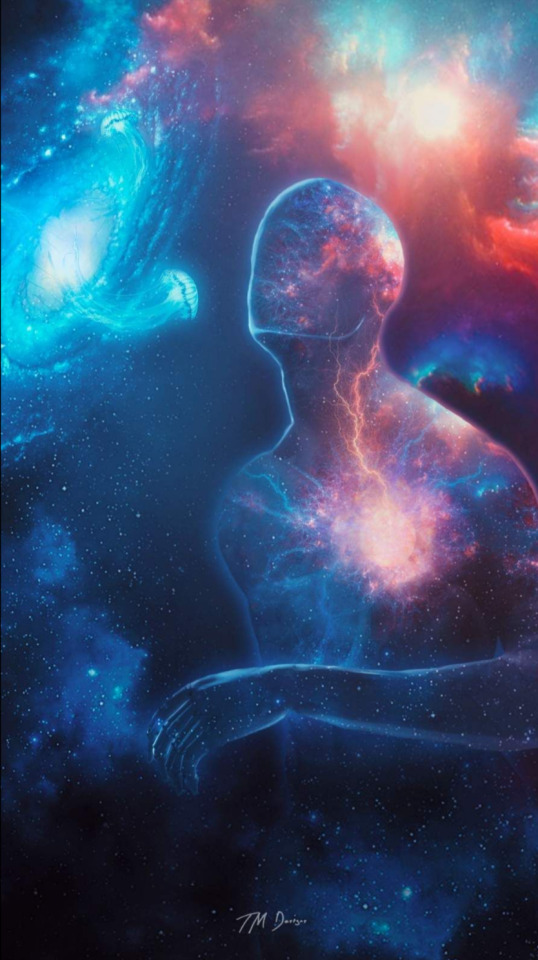
Coming together to encode or configure the Anthropos, Sophia and Christos act in a manner consistent with cosmic law, "for it is the will of the Originator not to allow anything to happen in the Pleroma apart from a syzygy" (A Valentinian Exposition 36.25-30). Syzygy is an odd Greek word used by astronomers to denote the conjunction of celestial bodies. The Originator wills that all activity in the Pleroma be accomplished by paired Aeons, coupled gods, but this is not a rigid rule, and it is not enforced. In the case of the Sophia-Christos syzygy that encodes the Anthropos, the will of the Originator is observed. Once it has been configured by the ritual dance of the coupled Aeons, the singulariry is ready to be projected into manifestation in the cosmos at large.
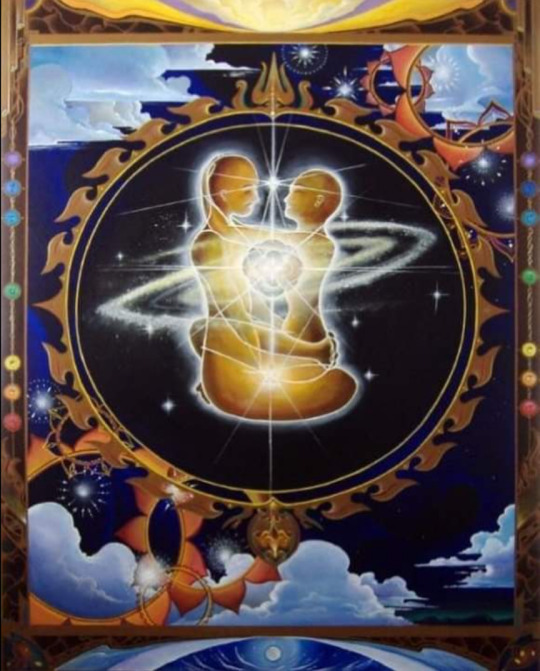
What next occurs in the Pleroma is a collective act, the collaboration of all the Aeons, not just Sophia and Christos acting as a distinct pair. In episode 3, the entire company of Pleromic gods unites in a choral dance to project the encoded singularity into manifesration. They seed it in the outer cosmos, the galactic limbs turning like a vast carousel around the Pleromic hub. The singularity nests in a nebular cloud. Although the language here is mythic, or mythopoetic, the description can be read as applying to the inner dynamics of the Galaxy. The myth clearly suggests astrophysical processes yet unknown ro science, but perhaps beginning to be glimpsed in plasma physics, complexity theory, and the new vision of emergence.
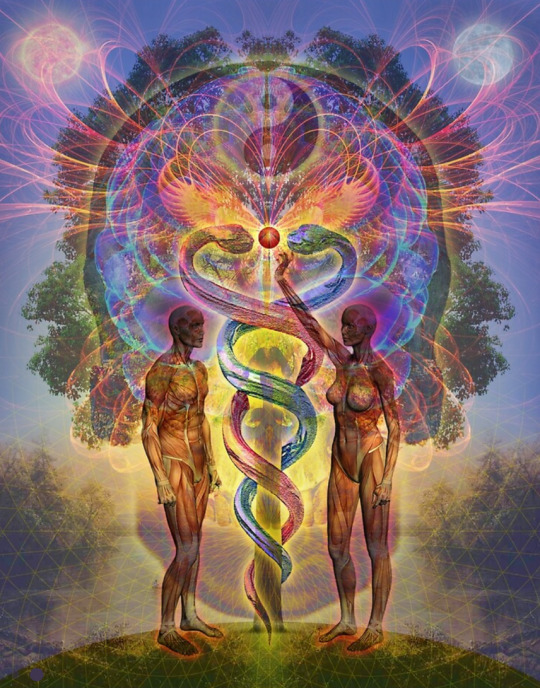
Pleroma means "fullness," "plenum," "plenitude." The galactic vortices are all variations of a chalice form, a flattened torus with a central core (the galactic bulge) and a surrounding disc (the spiral arms). The hub of a galaxy, its Pleroma, is counterbalanced by the flat carousel structure, the spinning armature, called the Kenoma, "deficiency," "formless realm." The Pleroma is a fullness, infinite potential that outpours itself into the realm of "deficiency," finite potential. In the Pleroma all possibility is complete, all is fulfilled, evolved ro its fullest potential. Pleromic gods like Sophia can only give of themselves, selflessly, without affecting what they emanate or imposing themselves upon the conditions they set up in the Kenoma. The selfless outpouring of the Pleromic gods is a key theme of Sophianic cosmology. It is also the model of human generosity.
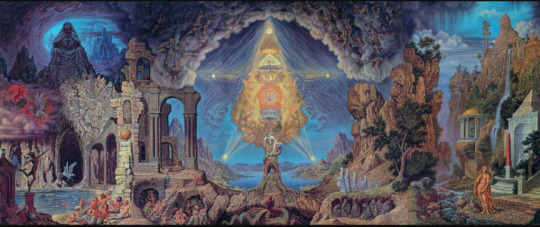
The Kenoma, the carousel armature of a galaxy, is the realm of chaos where finite, bounded potential develops. It is composed of dark elementary matter arrays (dema), atomic and subatomic fields, including organic elements, grains or spores of life. Suns are born in the galactic arms and planetary systems emerge there. On some of the planets organic life unfolds, but the origin of life cannot, it seems, be located on the planet where it arises. Nobel laureare Francis Crick, one of the discoverers of the structure of DNA, argues that, owing to its overwhelming complexity, life on Earth must have been seeded from elsewhere in the cosmos. Lynn Margulis, coauthor of the Gaia hypothesis, also accepts the possibility that microscopic life-forms (propagules) can migrate freely through interstellar space. The universe is a dusty place, and some of the dust is organic residue. That emergent life on planets in the carousel arms of a galaxy originates in the center of the galaxy, as described in episode 3, is not yet recognized by science. This theory will be unacceptable as long as scientists cannot imagine that the core of a galaxy is a vortex of superorganic forces, alive and aware, but this is the Gnostic vision of the Pleromas.
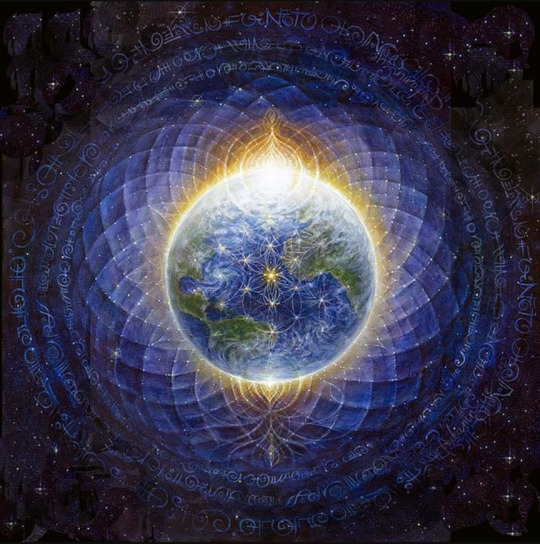
In Tantric cosmology, the composition of the Kenoma is called adrista, "residue." It is, as science tells us, stardust that remains from previous cycles of evolution, cycles without a beginning or end.
"Now the Eternity (which is absolute Truth) has no shadow outside it, for it is a limitless light where all is within and nothing is without. But at its exterior is shadow, which has been called darkness. From the darkness arises a force without form. This is the shadow realm of limitless chaos. From this realm, every kind of divine emanation emerges, including the world we inhabit, for whatever happens in chaos is previously implanted there by what produces it" (On the Origin of the World 98.20-30).
Here the language of the Mystery experience plays into the cosmological scenario. The galactic core is a spinning vortex of Organic Light, a radiant substance that might be compared to soft, luminous nougat. It casts no shadow. Darkness belongs to the exterior regions of the galactic mill wheel, the Kenoma. The residue of previous worlds is continually recycled and reprocessed in the massive armature of the spinning carousel. Whatever develops in the Kenoma was implanted there by Pleromic emanation-including humanity itself, or various strains of humanity, and other species.
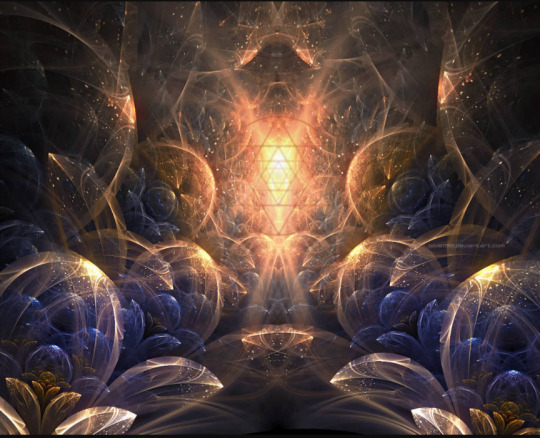
A striking parallel to the stalk of light in the Gnostic narrative occurs in the Japanese myth of creation where paired sky gods, or Kami, project a "Jewel-Sky-Spear" from the cosmic center into the waters of primordial chaos.' The image of cosmic fertilization in the galactic limbs occurs in Egyptian mythology where the sky goddess Nut, curved into an oval, carries the constellations of the zodiac encoded on her body. Cosmic embryonic imagery occurs in almost all high-culture cosmologies and universally in indigenous or "primitive" lore.

The text called On the Origin of the World (NHC II, 5) describes the boundary of the Pleromic core, called menix, hymen, stauros, or horos. Remaining in the core, Aeons can emanate into the arms, the realm of formless chaos, but they do not pass over into those regions. The opalescent stalk of light projected by the collectivity of Aeons may be compared to a klieg light shining through the wall of a white canvas tent. The beam of light passes through the walls, but the source of the beam remains inside the tent. Gnostics texts explain that these two primary conditions, Aeonic pairing and bounded emanation, are set by the Originator. They are cosmic laws but they are not enforced, so exceptions are possible.
Sophia is one of those exceptions.
#anthropos#gnosis#gnosticteachings#cosmology#johnlash#sophia#christos#aeon#plasmaphysics#magnetism#electricity#naghammadi#thegnostics#originstory#hierosgamos#divineunion#sacredmatrimony#sacredmarriage#divinefeminine#sacredmasculine#pleroma
20 notes
·
View notes
Photo

The two faced self one of my most detailed works ever -it's called "the two faced self" I was really inspired while drawing this one - it's one of my personal favorites so far Happy about comments 😊 #magicalartcontest23 #thetwofacedself #sacredmarriage #janus #jachinandboaz #duality #spiritualart #occultknowledge #symbolism #symbolicart #pastandfuture #theself #mushrooms #sacredmushrooms #thetwopillars https://www.instagram.com/p/CpVh96JsgAT/?igshid=NGJjMDIxMWI=
#magicalartcontest23#thetwofacedself#sacredmarriage#janus#jachinandboaz#duality#spiritualart#occultknowledge#symbolism#symbolicart#pastandfuture#theself#mushrooms#sacredmushrooms#thetwopillars
0 notes
Text
#onlinecounselling4u#premarital#premaritalcounselling#premaritalcounsellor#engaged#premarriage#datetomarry#marriageisforever#covenantmarriage#sacredmarriage#ilovemarriage#mywifeismybestfriend#marriageisforlife#myhusbandismybestfriend#marriageproblems#marriageforchrist#premaritalcounseling#premaritalsex#premaritalproblem
0 notes
Text









The ‘me-thought’ was born with initiation of mankind into a new phase in the story of consciousness (#evolution) - the ‘me-thought’ is not wrong - but is to serve the truth - however, identification with ‘me’ was initially unavoidable, so that much of this new world could come to be born through this new mind of man & its strong thinking capacity. But identification came with many dangers of separation & isolation, of duality, of a dominator & a victim. Now the possibility has once again come to disidentify with the thinking mind as an identity; or to purify the thinking mind of its untrue beliefs - so that it can become the true servant of #consciousness that is its function.
#consciousness#presence#awareness#spiritual#spirituality#revolution#consciousness revolution#evolution#maithuna#sacredmarriage#divinemarriage#duality#nonduality#selfrealization#advaita#divinefeminine#meditation#shaktism#gardenofeden#story of consciousness#the real revolution#heart revolution#Mary Magdalene#shakti#divinemother#love
0 notes
Photo
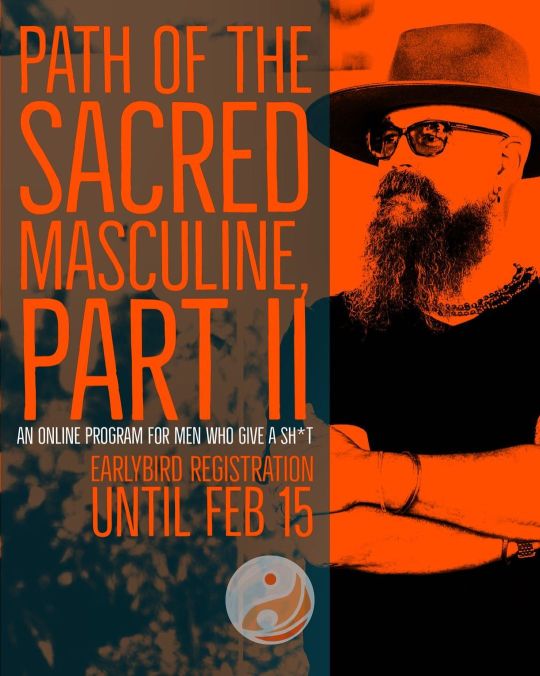
PART II, PATH OF THE SACRED MASCULINE A nine-month program for men who’ve completed Part I, Path of the Sacred Masculine nervous system training. Yes, this is for men who give a sh*t about themselves, their friendships, marriages, families, communities, their work, their purpose—and above all, their ART as masculine-identified men in this life. * Start March 1, 2023 * FMI sacredbodies.ca/path2 *Pre-requisite: Successful completion of Part I, Path of the Sacred Masculine • • #Menswork #Men #menshealth #mensmentalhealth #pathofthesacredmasculine #authenticrelationships #nervoussystem #nervoussystemregulation #nervoussystemhealth #nervoussytemtraining #newyear #newyou #masculineenergy #integrity #grit #husband #husbandman #husbandtraining #honesty #power #presence #masculinepresence #masculinepower #king #warrior #leader #leadership #marriage #sacredmarriage #sacredmasculine https://www.instagram.com/p/Cmw61mqyn7T/?igshid=NGJjMDIxMWI=
#menswork#men#menshealth#mensmentalhealth#pathofthesacredmasculine#authenticrelationships#nervoussystem#nervoussystemregulation#nervoussystemhealth#nervoussytemtraining#newyear#newyou#masculineenergy#integrity#grit#husband#husbandman#husbandtraining#honesty#power#presence#masculinepresence#masculinepower#king#warrior#leader#leadership#marriage#sacredmarriage#sacredmasculine
0 notes
Photo

The masculine becomes undone by learning to go within, removing the false layers that the fixation on his status or symbol in the outside world has asked of him, whilst the feminine becomes a charged symbol of change by looking outside of herself. Seeing how her physical presence betrays the secrecy of what has been happening within.. Her change then becomes ACTION, whilst he focuses on his REactions. — SeekCindy - To join my divine lovers school & receive guidance regarding how to attract:facilitate a divine love, or to book a masculine specific reading & understand the energy/intentions of your current masculine (whether he is currently operating from his shadow (karmic) masculine or whether he is operating in his divine masculine presence), DM myself or @seekserendipity_ to book our service now 🙏🏾✨🥰 Everybody deserves to experience the divine masculine in his true form at least once in their lives... #numerology #esoteric #gnosis #wisdom #sacredmarriage #sacredmath #empath #starseed #lightworker #divination #tarotreading #tarotcards #tarotreader #intuitive #intuition #predictions #forecast #twinflames #twinflameunion #divinefeminine #depression #bpd https://www.instagram.com/p/CWdin41sayy/?utm_medium=tumblr
#numerology#esoteric#gnosis#wisdom#sacredmarriage#sacredmath#empath#starseed#lightworker#divination#tarotreading#tarotcards#tarotreader#intuitive#intuition#predictions#forecast#twinflames#twinflameunion#divinefeminine#depression#bpd
5 notes
·
View notes
Text

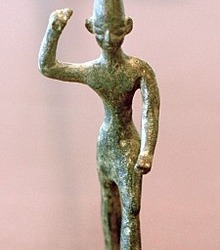
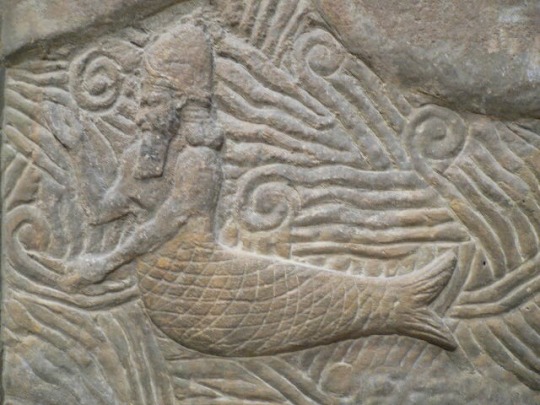
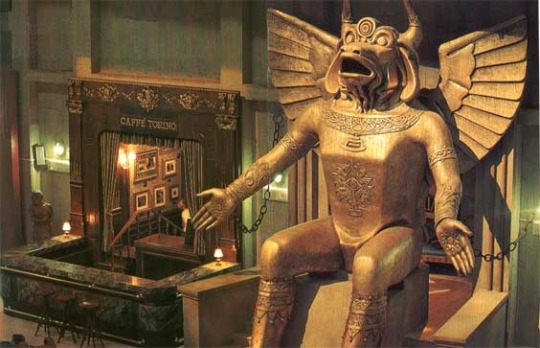
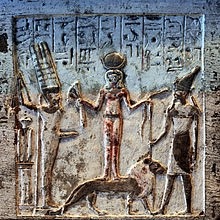
The early Semites and Canaanites had a number of Gods before eventually bringing the number down to two (Asherah and El) until finally settling into the monothestic Judaic religion. The old Canaanite and Semitic deities are as follows:
Adonai: Meaning “Lord”, Adonai is a name for God still used today.
Aglibol: Aglibol is a luna deity depicted with a moon halo decorating his head and sometimes his shoulders, one of his attributes is the crescent moon. Aglibol means “Calf of the Lord”.
Amurru: Amurru was an early storm and mountain God known to be based on the Mesopotamian Adad. Amurru’s consort was Asherah and he likely came to inspire both Ba’al and El who were also inspired by Enlil and Enki of the Mesopotamian mythologies.
Anat: Anat was a war Goddess, a virgin - likely meaning Hierodule as proven by the fact that she is also the consort and lover of her brother Ba’al Hadad. Anat appears as a fierce, wild and ferocious warrior in battle said to wade knee-deep in blood, striking off heads, cutting hands, binding the heads to her breast and the hands in her sash, driving out the old men and townsfolk with her arrows with her heart filled with joy. Anat is the mother of Aglibol. Anat in one myth slays the God of death, Mot to release Ba’al Hadad from the underworld, she also seems to parallel Ishtar slightly in a myth where she seeks to take vengeance against the hero Aqhat for refusing to part with his marvellous bow.
Asherah: Asherah is a Semitic version of the Sumerian Goddess Ishtar. Asherah is the consort of El with whom through Hieros Gamos she is said to have birthed the cosmos. Asherah was worshiped by early Hebrews up until their Exodus from Egypt when Yahweh alone became the monotheistic God of the Israelites.
Ashima: Ashima is a Goddess of fate and the working of destiny, she was still worshiped by the Samaritans long after the Hebrew people stopped worshiping her.
Astarte: Astarte (Depicted top left) was a Goddess of fertility, sex and war she was associated with Venus and thus likely modeled on the Sumerian Goddess Ishtar and came to later influence the Semitic demoness Lilith. In one myth Astarte is sent by the primordial God of heaven with her two sisters Asherah and Ba’alat Gebal to trick the God El however all three end up becoming consorts of El. In much later demonology Astarte is made into a masculine demon king called Asteroth.
Athirat: An ocean Goddess and varient of Asherah.
Attar: A Semitic male version of Ishtar and a war God representing the morning star, Venus. Attar often attempts to overthrow the God El and so may have been an early Semitic version of Lucifer/Satan - who also bares the epitaph “morning star”. Attar was a fertility God with power to cause rain. This male “morning star” may have lead to the development of Samael as the male veriant of Lilith.
Ba’al: Ba’al (depicted top row and central) means “Lord” however the title also refered to as specific deity. Ba’al was a God of the heavens, of storms and fertility. In the Bible when it says “the Lord said” this is likely a translation from the original “Ba’al said”, in later demonology Ba’al would be demonised as both the demon king Ba’al and Beelzebub or more accurately “Ba’al Ze Bub” meaning “Lord of flies”.
Ba’alat Gebal: Was one of three sister Goddesses including Asherah and Astarte sent to trick El but ended up being his consort instead.
Ba’al Hadad: Ba’al Hadad is the Semitic version of the Sumerian God Adad. Ba’al Hadad was a storm and fertility God that brough rain he also fought and killed the God of the sea, Yam who Yahweh had set up to take the throne of heaven, after which Ba’al Hadad was himself vanquished by the death God Mot and resurrected by Mot’s own death when he was slain by the warrior Goddess Anat who killed Mot in order to release Ba’al Hadad. Ba’al Hadad seems to be the chief of Gods in Canaanite mythology and has three consorts: Ba’alat Gebal, Asherah and Astarte.
Ba’al Hammon: Ba’al Hammon was a weather and vegetation God of fertility, he was often depicted with horns and was the husband of the Goddess Tanit. Ba’al Hammon was likely demonised as the demon “Mammon” which rules over materialism and is closely associated with another Canaanite God-turned-demon; Moloch.
Ba’al Shamin: Ba’al Shamin is thought to be a solar deity or a heaven deity and is often depicted in a trinity with the moon God Aglibol and the sun God Malakbel. Ba’al Shamin was originally used as a title and of Ba’al Hadad although later he seems to become a God in his own right.
Ba’al Zephon: The God Ba’al in his role as lord of Mount Zephon - the Canannite home of the Gods.
Chemosh: Chemosh was the head God of the Moabites in their tradition he was often appeased by human sacrifice by fire, Chemosh in the Moabite cosmology is paired with Astarte in the form of Ashtar and the two in sacred marriage symbolism are paired as one androdgynous being known as Ashtar-Chemosh.
Dagan: The Mesopotamian deity Dagon (depicted top right) was worshiped by early Semites under the name “Dagan” his mythology remains the same however his interactions with Sumerian deities are replaced by their Semitic counterparts.
El: El meaning “God” became identical with Yahweh and eventually became the monotheistic God of the Hebrew Bible however he is clearly modeled on the Sumerian Gods Enlil and Enki. El was the chief deity of the early Semitic pantheon. El was a storm and mountain God as well as the creator God of Heaven, he is nearly identical with all forms of Ba’al. El was the father of the other Gods in a sacred marriage with Asherah, these other deities became the “Elohim” - “Children of El” which was later translated in the Bible as “Sons of God” and came to mean angels. El was originally the husband of three Goddesses; Ba’alat Gebal, Asherah and Astarte. In Canaanite combat myths it is El that vanquishes the great primordial beasts; Behemoth, Ziz and Leviathan in order to create the universe from their corpses showing a reference back to the Sumerian myth of Marduk and Tiamat.
El Elyon: A title of El meaning “God of the most high”.
Eshmun: Eshmun was a mortal man who was harassed by the Goddess Astarte and so cut off his own genitals in ritual castration and died he was then resurrected and made a God of healing. Since the cause of his castration is a Goddess and castration often implies sacred union this myth is clearly a Hieros Gamos mythology since it also follows the pattern of death followed by resurrection and ascent into Godhood.
Gapn: Gapn was a messanger of Ba’al and was a God of vines and wine.
Horon: Horon was a God of destruction and chaos.
Ishat: Ishat was a Goddess of fire slain by Anat.
Itum: Itum was a Goddess and consort of the God Resep.
Jehovah Sabaoth: Meaning “Lord of Hosts” or “Lord of Armies/Powers”. “Jehova” is regarded as a pronounciation of “Yahweh” and so the two deities are practically identical with Jehova being seen as Yahweh in battle or as an aspect of Yahweh with a focus on war.
Kades: A mother Goddess of fertility often described as the fertility aspect of Astarte.
Kothar: The God of metallurgy and blacksmithing he was known to have created a marvellous bow for the hero Aqhat and two magic maces or clubs for Ba’al/El. Kothar was also an architect, carpenter and magician and was known to build the palaces of the other Gods, create spells and enchantments and bless deities with gifts of silver or gold furniture. Early Semitic builder cults probably venerated Kothar.
Kotharat: The Kotharat, meaning “skillful ones” were a group of seven moon Goddesses associated with swallows, they were divind midwives who helped women in childbirth and they themselves are seen as Hierodules/sacred prostitutes almost certainly having a connection to Hieros Gamos rites. The Kotharat were sometimes refered to as “Sasurartum”.
Malakbel: Malakbel was a solar deity often shown in trinity with Ba’al Shamin and the luna God Agibol. Malakbel was seen as a messanger of Ba’al - a term which is believed to have been rendered “angel of the Lord” in later Biblical interpretations.
Marqod: Also known as Ba’al Marqod meaning “Lord of the dance” was a God of healing and dancing as the two are thought to be linked and probably relating to ritual dancing. Interestingly the term Lord of the dance later became synonymous with Jesus Christ because of a Christian hymn which gives him the title.
Moloch: Moloch (modern recreation depicted lower left) was a Canaanite God. Moloch comes from the Canaanite “Mlk” meaning “King” and is often ascribed to various male deities in the Canaanite pantheon however Moloch is also a demonic deity depicted with a bulls head and horns and outstretched arms. There is a strong belief that the Canaanites would sacrifice their own children to be burned alive in the arms of a statue of Moloch to the beat of ritual drums this was considered a powerful sacrifice that would win the favour of the Gods since they had given something precious to themselves rather than property such as livestock or captured enemies, the sacrifice was known as a “burnt offering to God/Moloch” and is rendered in the Bible as the Biblical term “Holocaust” which has the same meaning. In modern demonology Moloch is often described as a demon.
Mot: Mot is the deification of death said to have dwelled on a throne in a low pit, in on myth he is invited to a feast by Ba’al Hadad who wishes Mot to submit to him, in this same myth Mot is refered to as “divine death” and so he may be a special kind of death God which only kills other Gods. In response to Ba’al Hadad’s request Mot claims his hunger is relentless and threatens to eat Ba’al Hadad himself, which according to the myth he achieved before being slain himself by the war Goddess Anat who cuts Mot into pieces in order to free and thus resurrect Ba’al Hadad. The reference to the hunger of Mot may influence later Semitic and Biblical depictions of death as a force that eats or swallows.
Nikkal: Nikkal was a Goddess of orchards and fruit and was known as “great lady and fruitful”, she is therefore also a fertility and vegetation Goddess thought to be based on the Mesopotamian Goddess Ningal.
Onca: Onca was a Canaanite Goddess of wisdom closely associated with the later Greek Goddess Athena.
Pidray: Pidray is one of the daughters of Ba’al and a Goddess of light and mists.
Qetesh: Qetesh (bottom right) was an aspect of Asherah described as a fertility Goddess and a Goddess of sacred prostitution linked with sacred marriage rites. Qetesh was also worshiped in Egypt where she was depicted as a forward-facing naked woman on top of a lion with a Uraeus and sun-disc on her head, often depicted holding a snake and lotus flowers she may therefore be related to Kundalini/serpent energy mysteries. Qetesh is the first known tripple Goddess in one form known as Qudshu-Astarte-Anat (wherein “Qudshu” is taken to mean Qetesh) from this it may be taken that Qetesh is synonymous with Asherah and Anat may also relate to Ba’alat Gebal since Asherah-Astarte-Ba’alat Gebal are also a set of Canaanite Goddesses who are mentioned in triplicate as the consorts of El.
Rabbim: Rabbim was a God of floods killed by the war Goddess, Anat in some myths but is more commonly said to have been slain by El/Yahweh or Ba’al. Rabbim may therefore be identical to the sea monster Rahab.
Resep: Resep is a God of illness and a deification of plagues, in some texts he is an attendant of Yahweh.
Resheph: A horned archer God whose name means “lord of the arrow”, Resheph was known as a war deity associated with protection from plague, the God Resep may therefote be a later corruption of Resheph. Resheph likely relates to the Sumerian God Pabilsag since Pabilsag is described as a horned bull synonymous with the archer of the Zodiac; Sagittarius.
Sapas: Sapas was a solar Goddess, a messanger of El and a healer, she was also known to lead souls through the underworld acting as a psychopomp just as the sun is seen to descend into the underworld at sunset. Sapas is also described as all seeing and called by the title “torch of the Gods”, this may have influenced later Semitic and Biblical omnipotent sun Gods and the Masonic symbol of light or “all seeing eye”/“eye of providence”.
Shahar: Shahar was the God of dawn and was brother of Shalim, he was born of the union of El and Asherah. The concept of the sun having different personifications depending on its position in the sky is likely influenced by Sumerian and Egyptian cultures.
Shalim: Shalim was the God of dusk and brother of Shahar, like Shahar he was born of the union of El and Asherah.
Sydyk: Sydyk was a Goddess of justice and judgement and was connected to the planet Jupiter, she was probably based on Roman mythology as she appears much later than other Phoenician deities.
Tanit: A mother Goddess likely based on Astarte, she was a consort of Ba’al Hammon and a Goddess of war, fertility, virgins (Hierodules) and nurses. There is some archeological evidence and written historical evidence to suggest that the worship of Ba’al Hammon and Tanit may have resulted in the sacrificing of children, this in turn may relate the two deities to Moloch and may be the cause of the demonisation of Ba’al Hammon into Mammon.
Yahweh: Yahweh was a divine warrior God of storms, war, mountains and the heavens. The name Yahweh likely started out as a title of Ba’al and/or El before becoming a God in his own right and ultimately becoming one with both these figures as the monothestic God of Judaism and the Hebrew Bible which likely relates back to the volcanic mount Sanai in later Hebrew mythology. Yahweh developed as the God of Israel and Judah and was the husband of Asherah before she too was mostly removed from the newly formed Jewish religion being refered to as titles such as “Shekhina” meaning “Holy Spirit” or “Bride of God”.
Yam: In the original combat myths of the Canaanites Yam is an ocean God thought to be modeled on the Sumerian God Anzu or Goddess Tiamat or perhaps even Kingu. Yam is sent by his father El to attempt to usurp the throne of heaven and succeeded making himself the master of the Gods and working them as slaves, the Gods in turn pray to their mother Asherah who goes before Yam and offers her body (sacred prostitution) in exchange for releasing the other Gods which Yam then accepts. Asherah goes back and relates this deal to the other Gods and Ba’al Hadad in rage protests and insights a war against Yam finally slaying him with the twin maces forged for him by the smith God Kothar. Slaying Yam in turn made Ba’al Hadad king of the other Gods. This mythology is clearly based on the uprising of the Gods behind Marduk in battle against Anzu, Tiamat and Kingu.
Yarikh: A moon God and husband of Nikkal, his dew was seen to make Nikkals flowers flourish and he was known as the “illuminator of the heavens” and “lord of the sickle”. It is unknown if this God relates to alchemical “Heavenly Dew”.
#post142#mysticism#religion#mythology#hierosgamos#sacredmarriage#goddess#god#canaanites#semitic#kundalini#holocaust#israel#demonology#masonry#sacrifice#lilith
42 notes
·
View notes
Text

My Twin Flame is my everything. We are married, we have been through so much together. His heart is all I wanna own.
On this social network I don't use my knowledge to help out other Twin Flames, so if anyone feels spoken to I will respond gladly.
I am a natural healer and empath.
#twinflames#twin flame#spiritualawakening#spiritualgrowth#spiritualpath#ascension#growing#healing#loving#positivity#sacredmarriage#divinefeminine#divinemasculine#eternallove#mental heath support#healthy relationships
42 notes
·
View notes
Photo

The separation of feminine and masculine has torn us into pieces. The balance of feminine and masculine will bring us back to peace. 🙏🏼 #marymagdalene #sacredmarriage (en Dervaig, Argyll And Bute, United Kingdom) https://www.instagram.com/p/CC8nNtglTMI/?igshid=159ri1a9i3ikb
0 notes
Photo

New Episode 51: How to find Sacred Union, Conscious Love, Spiritual Marriage, Self-Love! ⚡️ Sweetest couple interview ever!! I love Jeanette Rios of I Am Sacred & Brandon Evans of 1Heart. You will too when you listen to us vibrate together.⚡️💖#consciouslove #sacredmarriage #speaktruth https://www.instagram.com/p/B85jaeZA5a-/?igshid=ug922r8a0cuh
0 notes
Photo

We celebrated our 16th Marriage Anniversary at one of most sacred places on the earth, Rishikesh, also known as the Yoga Capital of the World. We along with family members, visited some holy places over there, and got blessings of Yogis, Monks, Seers, and Deities. #rishikesh #marriageanniversary #marriedlife #lovebond #lifepartner #sacredmarriage #sacredrelationships #spiritualjourney #lifejourneys (at Rishikesh - Yoga Capital of the World) https://www.instagram.com/p/By2pekkl8g6/?igshid=gczq8hl5eyuc
#rishikesh#marriageanniversary#marriedlife#lovebond#lifepartner#sacredmarriage#sacredrelationships#spiritualjourney#lifejourneys
0 notes
Photo

Ladies listen... #christianwomen #christianmarriage #christianwife #Christianhusband #christiandating #christianfamily #christianfamilyorganizations #christianfamilies #christianmen #covenantmarriage #marriageproblems #marriageisforlife #marriageisforever #marriageforchrist #sacredmarriage #myhusbandismybestfriend #mywifeismybestfriend #virtuouswoman #goodwoman #goodwomen #futurewife #dearfuturewife https://www.instagram.com/p/Bs-_a2VAMSVlv9aqV2TDn3RbGItW5Vu55XaBiY0/?utm_source=ig_tumblr_share&igshid=195xd6iru8tel
#christianwomen#christianmarriage#christianwife#christianhusband#christiandating#christianfamily#christianfamilyorganizations#christianfamilies#christianmen#covenantmarriage#marriageproblems#marriageisforlife#marriageisforever#marriageforchrist#sacredmarriage#myhusbandismybestfriend#mywifeismybestfriend#virtuouswoman#goodwoman#goodwomen#futurewife#dearfuturewife
0 notes
Photo

Take a deep breath. Now, read it twice. 👌✨ ・・・ The dissembling of the everything into the nothing... Prepare for 'epiphanies' that make you realise that you already knew everything all along. The number 10 represents a paradox. Starting entirely anew simply by revisiting all that has been old. As timelines & fortunes collapse into one another, do not forget to keep the Big Bang theory in mind. It was the nothing that collided to form existence. Do not be so in a rush to perceive, or to act. Instead, simply become. Remember to pause in the spaces inbetween the transitions, lest you miss the entire script, for the next lifetime. - Seek Cindy. #numerology #esoteric #gnosis #wisdom #sacredmarriage #sacredmath #empath #starseed #lightworker #divination #tarotreading #tarotcards #tarotreader #intuitive #intuition #predictions #forecast #twinflames #twinflameunion #divinefeminine #depression #bpd
#intuition#predictions#depression#tarotreading#starseed#sacredmath#tarotreader#forecast#divination#twinflameunion#esoteric#gnosis#twinflames#lightworker#numerology#sacredmarriage#divinefeminine#empath#intuitive#wisdom#tarotcards#bpd
0 notes
Photo

Beltane is just around the corner. Time to enjoy the spring flowers, leaving offerings to the fey and honor the sacred marriage of the Lord & Lady. #traditionalwitchcraft #celticsabbat #mayday #maypole #maypoledance #beltane #beltain #beltaine #dancethering #fae #mayqueen #mayflower #sacredmarriage #handfasting #paganwedding #firefestival #outdoorloving #godandgoddess (at Winlock, Washington)
#traditionalwitchcraft#maypole#sacredmarriage#fae#dancethering#mayday#outdoorloving#paganwedding#beltane#mayqueen#celticsabbat#mayflower#handfasting#beltaine#beltain#firefestival#maypoledance#godandgoddess
0 notes
Photo

There are a lot of attacks on the 144 right now.. I've already explained who/what the 144 are. And if you identify as being apart of them, then just please know that these attacks ARE a distraction: because of how close you are to purpose & passion. So the 144 in the bible are the 'chosen ones'. Now this is not to be taken SO literally in the context that there are only 144000 of God's chosen people, because a lot of ppl like to take the bible SO literally, that's why you're lost & turned out out here.. A lot of the bible deals with symbolism & metaphors, & you need to be able to interpret that or you'll be walking around out here thinking you need to be stoning some women, or keeping some slaves or whatever mess is taken from LITERAL interpretation. If you break down this number, it simplifies to the number 9. And what do we know about this number? It represents completion. The healing of wounds. The ability to salvage Godliness after continuous & arduous trials & tribulations.. These are the ones who have OVERCOME the great trials & tribulations. They've suffered pain. They've suffered persecution. They've got the metaphysical lashings on their soul to show for it. And what do they do, instead of turning to darkness? They become teachers. They are CHOSEN because they choose themselves. Some people are given great burdens and crumble underneath the pressure. Become narcissists/sociopaths etc.. Others, volunteer to transmute pain, to learn about it, to activate Christ consciousness & Christ likeness.. #numerology #esoteric #gnosis #wisdom #sacredmarriage #sacredmath
10 notes
·
View notes
Text

Ishum: The attendant of Erra and brother of Shamash. Ishum was a God of fire and a herald of war.
Isimud: The messanger of Enki. Isimud has two faces looking in opposite directions much like the later Roman God Janus.
Istaran: A God of politics symbolised by a snake.
Kabta: The husband of Ninsi’anna.
Kakka: The attendant and minister of state to both Anu and Anshar.
Ki: Ki was the consort of Anu the God of the whole heaven and Ki herself was the Goddess of the whole earth. Both Anu and Ki were born from the death of Tiamat/Nammu. Anu and Ki merged in a sacred marriage that caused the birth of the other Gods, the Anunnaki meaning “children of Anu and Ki” or “those who came down from heaven (Anu) to the earth (Ki)”
Kingu: Kingu’s name means “Unskilled labourer”. Kingu was a child of Tiamat/Nammu and after the murder of her husband Abzu she gave the tablets of destiny to Kingu congfirming him as ruler of the universe, king of the Gods and general of her army of monsters until Kingu was slain by Marduk and the tablets reclaimed. Kingu’s blood and flesh were later used in the creation of the Igigi.
Kishar: Whose name means “Whole Earth”. Kishar was the consort and sister of Anshar and mother of Anu. Kishar is the daughter of Lahmu and Lahamu, the first children of Tiamat/Nammu and Abzu. Kishar was a mother Earth Goddess.
Kulla: Kulla is the God of bricks and buildings he was said to have been a piece of clay that Enki had taken from the primordial oceans (Tiamat/Nammu and Abzu). Kulla was invoked by builder cults in a ritual involving a brick that represented him, precious metals, stone, incense and foods alongside the sacrifice of a lamb when a new building was to be made, Kulla would then be banished to the underworld on a boat when the building was completed in order that it would not require further work and to trap and malicious spirits within the brick representing Kulla as it was floated down stream. Kulla is therefore connected to exorcisms, banishing, building and the sanctifying of areas, he is likely an influence on the later Egyptian Ushabti and Semitic Golems.
Kus: Kus was the God of herdsmen.
Lahamu: Lahamu is a Goddess born of the union of Abzu and Tiamat/Nammu, she was consort of her twin brother Lahmu and gave birth to Anshar and Kishar who in turn gave birth to Anu and Ki who in turn gave birth to the Anunnaki.
Lahar: Lahar was the God of cattle created by the Anunnaki alongside his sister Ashnan - the Goddess of grain to populate the Earth with their children crops and cattle to provide food for the Gods.
Lahmu: Lahmu is a God born of the union of Abzu and Tiamat/Nammu, he was husband of his twin sister Lahamu who gave birth to Anshar and Kishar who in turn gave birth to Anu and Ki who in turn gave birth to the Anunnaki.
Lamga: One of the Mesopotamian Gods that was sacrificed in the creation of humanity, they are refered to as the “two lamga gods”, they were not used to create the Igigi as the text specifically mentions the creation of humans resulting from their death. In later Canannite mythology Lamga is described as an androdgynous or hermaphrodite deity that later became known to Kabbalists as “Adam Kadmon” (the universal archetype of man). Lamga therefore supports the Kabbalistic assertation that human beings were originally hermaphroditic before being divided into genders. Lamga may also describe the “Dark Race” or “Black Heads” referenced in the creation of humanity by the Anunnaki.
Lugalbanda: Lugalbanda was a Sumerian king identified as the husband of Ninsun and father and God of Gilgamesh.
Lugal-Irra: A lesser form of the plague God Erra.
Lulal: The brother of Ishtar who was appointed God of the city of Bad-Tibiria by Ishtar. Lulal was featured in exorcism rituals.
Mami: Sometimes thought to be identical to Ninhursag, Mami was the Goddess who fashioned wombs of clay to create the Igigi (and possibly humans) utilising genetic matterials gathered from sacrificed Anunnaki Gods.
Mamitu: Mamitu was the goat-headed Goddess of destiny and fate, she was also a consort of Nergal and became a Goddess of law, oaths and judgement. Mamitu was sometimes considered a demon of irrovocable curses.
Mandanu: God of divine judgement.
Manugal: Manugal was the consort of Birdu, she carried out judgement against the wicked.
Marduk: Whose name means “Solar Calf” was the God of storms chosen by the other Gods to wage war against Tiamat/Nammu. Marduk took the position of chief of the Gods after killing Tiamat but was later replaced by Enlil. Marduk rode a chariot drawn by four horses with poison in their mouths, he uses divine winds and lightning as weapons and was given a magical net, an invincible spear, a mace (probably sharur) and a bow with wind arrows to aid him in combat. Marduk killed many of Tiamat’s monsterous children before killing Tiamat by standing on her hind, smashing her skull, cutting her in half and dividing her body with the wind arrows. Marduk uses Tiamats body to form the heavens and the earth. Marduk kills Kingu and reclaims the tablets of destiny making him king of the Gods, in some myths there is a reference to Marduk being formed from a combination of all the Anunnaki Gods who merge together to face Tiamat, Marduk was himself said to be a grandchild of Tiamat which may explain this as Tiamat births the Gods who then “birth” Marduk by co-merging. Marduk was associated with the planet Jupiter and may have influenced the later Greek God Zeus. Marduk was associated with water, vegetation, magic and judgement. Marduk was consort of the Goddess Sarpanit. Marduk was the son of Enki and Damgalnuna. Marduk was a deity associated with Hieros Gamos rituals where the king of Sumeria would assume the role of Marduk.
Muati: A deity associated with the mythical paradise of Dilmun.
Mummu: Mummu is a primeval deity and advisor are to Tiamat and Abzu. Mummu was a craftsman and his name means “Knowledge” or “Life giving force”. Mummu was sealed away with the remains of Abzu during the battle with Tiamat.
Mushdamma: Mushdama was the “great architecht of Enlil” and was the deity of buildings and foundations he was likely worshiped by builder cults and involed alongside the God of bricks Kulla. This character may have influenced later Masonic descriptions of a “Grand Architecht of the Universe”.
Nabu: Nabu means “To Call”. Nabu was the God of scribes associated with the planet Mercury. Nabu was the chief scribe of Marduk/Enlil and kept the tablets of destiny as well as being charged with recording all manner of science, magic and religion. Nabu was a God of fertility, wisdom, water. Nabu’s consort was Tashmetum.
Nammu (Tiamat): Tiamat was the great primordial salt water ocean often taken to mean space or time. In a sacred marriage with her husband Abzu the primordial fresh water God she birthed the first deities Lahmu and Lahamu who went on to create Anu and Ki who spawned the Anunnaki. Lahmu and Lahamu may thus be considered fragments of Tiamat that comerged into Anu and Ki. The Gods turned against Abzu killing him and enraged Tiamat transformed into a terrible dragon, she gifts the tablets of destiny to her son and consort Kingu making him king of the Gods and births monsters and dragons to make war with the Gods. Tiamat is killed by Marduk who fashions physical existance (Anu and Ki) from her remains.
Namtar: Namtar was a death God and messanger of Ereshkigal, Anu and Nergal. Namtar was responsible for disease and pests and was born from a union between Ereshkigal and Enlil. It was said that he commanded sixty diseases in the form of demons that could penetrate different parts of the human body and offerings were made to him to prevent or cause those blights. On the order of Ereshkigal, Namtar curses Ishtar with all sixty diseases while Ishtar is trapped in the underworld.
Nanaya: Nanya was a Goddess of sex and fertility characterised by sensuality and voluptuousness. Nanaya was like connected to Hieros Gamos rituals.
Nanshe: Nanshe was the daughter of Enki and Ninhursag. Nanshe was a Goddess of social justice, prophecy, fertility and fishing. Like her father Nanshe was associated with water. Nanshee had the ability to give oracular messages and determine the future and through dream interpretation. Nanshe’s priests were also granted these abilities after conducting a ritual death and resurrection.
Negun: A deity referenced in Mesopotamian texts with no known function.
Nergal: Nergal is the son of Enlil and Ninlil he was associated with the planet Mars. Nergal was a God of war and disease and also represents the sun at noon. In later mythology Nergal would become a God of the underworld and consort of Ereshkigal. There is some confusion between Ninurta and Nergal since both are shown wielding Sharur. Nergal was a God of deserts and fire.
Neti: Neti is the keeper of the gate of the underworld and servant of Ereshkigal, he is the one who leads Ishtar into the underworld.
Ngeshtin-ana: The sister of Tammuz and Goddess of the heavenly grape vine she is also the Goddess of wine and cold seasons, she is an interpreter of dreams and a divine poet. Ngeshtin-ana is the daughter of Enki and Ninhursag.
Nidaba: Nidaba was the Goddess of writting, learning and the harvest. Nidaba appears with flowing hair, crowned with horned tiara baring supporting ears of grain and a crescent moon. Nidaba is the daughter of Anu and Uras, she is the sister of Ninsun. Nidaba may be the mother of Ninlil.
Ninazu: Ninazu was a God of the underworld and of healing. Ninazu was the son of Enlil and Ninlil or in alternative traditions, of Ereshkigal and Gugulana and was father of Ningishzida. Ninazu was the consort of Ninsutu.
Nindara: The consort of Nanshe.
Nindub: God associated with the city of Lagash.
Ningal: Ningal was Goddess of reeds and daughter of Enki and Ningikuga and the consort of the moon God Sin by whom she bore Utu/Shamash the sun God, Ishtar and in some texts Ishkur.
Ningikuga: Goddess of reeds and marshes and a daughter of Anu and Ki. Ningikuga was the consort of Enki and mother of Ningal.
Ningirama: A minor God of magic invoked against snakes.
Ningishzida: Meaning “Lord of the good tree”. Ningishzida was an underworld deity sometimes depicted as a serpent with a human head. Ningishzida was also depicted as a double helix or caduceus of serpents that may have represented DNA and/or kundalini/serpentine energy forces. Ningishzida was associated with the Sumerian tree of life and thus Kabbalistic mysteries.
Ninhursag: Ninhursag is a fertility deity and great mother Goddess associated with nature and mountains. Ninhursag is often depicted with hair in the shale of the Greek letter Omega. Ninhursag often wears a horned head-dress and tiered skirt, often with bow cases at her shoulders and sometimes carries a mace or baton, she is surmounted by an omega motif or derivative and sometimes accompanied by a lion cub on a leash. Ninhursag was the consort of Enki and was a merging of many Mesopotamian Goddesses. Ninhursag births Ninsar through Enki and then Ninsar births Ninkurra through Enki who then bares Uttu, Uttu is then seduced by Enki but dumps his seed on the ground after consulting with Ninhursag causing plants to grow, Enki eats the fruit of these plants and becomes impregnated by his own semen but cannot give birth and becomes deathly ill. Ninhursag absorbs the semen from Enki birthing deities of healing to save Enki’s life.
Nin-Ildu: God of carpenters.
Nin-Imma: Nin-Imma was born of Enki and Ninkurra, she is the deification and personification of the female sex organs and is therefore a Goddess of sex and fertility likely associated with Hieros Gamos.
Ninkarnunna: God of barbers and attendant of Ninurta.
Ninkasi: A Goddess of healing born of Ninhursag after absorbing Enki’s semen. Ninkasi is the Goddess of beer and was said to prepare the drinks daily.
Ninkilim: God of wild beasts, in particular vermin.
Ninkurra: A daughter of Enki who bore the sun God Utu/Shamash and Nin-Imma. Ninkurra was the Goddess of pastures.
Ninlil: The daughter of Anu and Ki and consort and sister to Enlil. Ninlil is the mother of Ninurta who she spawned with Enlil, throughout the myth of Enlil and Ninlil, Enlil rapes Ninlil by disguising himself and seducing her from these encounters she also births the moon God Sin (which caused the Ninlil and Enlil to both be temporarily banished to the underworld) they also bore Nergal, Ninazu and Enbilulu. Ninlil is the Goddess of the wind and some sources acredit her with becoming the later Goddess Lilitu (as opposed to Ishtar becoming Lilitu).
Ninsar: Goddess of plants and daughter of Enki by Ninhursag she went on to bare her fathers daughter Ninkurra.
Ninshubur: Second in command of Ishtar and also her handmaiden, the two were good friends although Ninshurbur is a Goddess of messangers in her own right, in one myth she helps Ishtar steal the sacred me’s from Enki and in the story of Ishtars descent it is Ninshurbur who pleads with Enlil to create Asu-Shu-Namir in order to release Ishtar.
Ninsi’anna: Goddess called the “red lady of the heavens” and associated with Venus. This may imply she is another identity or name of Ishtar.
Ninsun: A Goddess of cattle born of Anu and Uras, she was the mother of Gilgamesh.
Ninsutu: One of the healing deities born when Ninhursag absorbed the semen trapped in Enki. Ninsutu was consort of Ninazu.
Ninti: Known as the “lady of the rib” (potentially a connection to Eve in Genesis). Ninti was a Goddess of healing born of Ninhursag when she absorbed the semen trapped in Enki.
Nintinugga: The daughter of Anu and consort of Ninurta. Nintinugga was a Goddess of life and healing although she was also called upon to curse those who have done wrong.
Nintulla: One of the healing deities born when Ninhursag absorbed the semen trapped within Enki.
Ninurta: God of hunting and war who would later come to be synonymous with Nergal. Ninurta was the son of Enlil. Ninurta wields the enchanted mace Sharur and uses it to slay many monsters, dragons and demons including Anzu in order to reclaim the stolen tablets of destiny. Ninurta was associated with the planet Saturn. Parallels have been drawn between Ninurta and Marduk.
Nisroch: A God of agriculture, some scholars claim he is eagle headed while others claim the same image references the Apkallu.
Nu Mus Da: God of the lost city of Kazallu.
Nunbarsegunu: Mother Goddess of barley also sometimes considered the mother of Ninlil.
Nuska: A ferryman and scribe subservient to Enlil, Nuska was said to have taken Enlil to his wife Ninlil.
Nusku: A fire God seen as a mediator between humanity and the Gods, he is almost indistinct from Gibil.
Pabilsag: Known as the “Wild Bull with multi-coloured legs” and is best known as the consort of Ninsun and for bringing gifts to Enlil. This deity is later associated with Sagittarius in Sumerian astrology
Pap-Nigin-Gara: Known as the “Lord of the boundry stone” and possibly synonymous with Ninurta.
Papsukkal: A messanger God and gatekeeper, he was consort of Amasagnul.
Sarpanit: Possibly the same as Ishtar she was worshipped with the rising moon and at new year festivals, she was often depicted as pregnant and may have been synonymous with the Goddess Mami. Sarpanit was likely associated with the Hieros Gamos rituals, her titles were the “shining one” and “creatress of the seed”, she was the consort of Marduk.
Shala: Shala was a Goddess of grain and compassion signifying that an abundance of crops was compassion for mankind from the Gods. Shala was the wife of Dagon and consort of Adad.
Shara: Son of Ishtar and God of war.
Sharra Itu: A fertility Goddess who bore the title “the bride” signifying that she had a role in Hieros Gamos sacred marriage ceremonies.
Shullat: Personal attendant of the sun God Shamash/Uttu and personal guard of Adad.
Shulmanu: A God of the underworld, fertility and war.
Shulsaga: An astral Goddess of the stars.
Shu-Pa-E: Shu-Pa-E was an astral and fertility God and consort of Ninhursag.
Sibitti: The seven Sibitti were described as war Gods in the form of terrible wepons they were the children of Ishara and they called upon Erra to bring an end to mankind causing chaos in the ancient world.
Siduri: Goddess of fermentation, of beer and wine. Siduri attempts to dissuade Gilgamesh in his quest for immortality, urging him to be content with the simple pleasures of life. Siduri also tells Gilgamesh where he can find Atrahasis.
Silili: A deity mention by Gilgamesh when he proclaims the misfortune of the lovers of Ishtar, he claims the mother of horses, Silili is left to weep for the horse that Ishtar loved, suggesting that Silili is a horse Goddess.
Sin (Nanna): Sin was a moon God born in the underworld from the union of Enlil and Ninlil. Sin would at points become regarded as chief of the Gods. Sin was refered to as the “lord of wisdom” in regards to astrology and astronomy. Sin’s consort was Ningal who bore him Ishtar and Utu/Shamash. Sin was said to have a beard made from Lapis Lazuli and to ride a winged bull. Enlil and Ninlil were imprissoned in the underworld as punishment for birthing Sin this may indicated the origin of the term “Sin” to mean a transgression against divine law.
Siris: A Goddess of beer and daughter of Ninkasi. Siris was mother to the demon Anzu.
Sirsir: The Goddess of sheep and inscriptions who became synonymous with Ninsun.
Sumugan: Son of Shamash, Sumugan was an underworld God of rivers and cattle.
Suzianna: The second wife of the God Enlil.
Tammuz: Originally based on the Sumerian king Dimmuzid the shepherd, according to the myths Tammuz was married to Ishtar. Tammuz became a God of vegetation. In the descent of Ishtar, Tammuz is seized by Gallu demons and taken into the underworld in her place due to his lechery. The myth is a metaphore for sacred marriage and helps to explain the changing of season from winter to spring.
Tashmetum: The consort of Nabu, Tashmetum’s primary role is to listen to prayers and graunt requests.
Tishpak: God of the city of Esnumma.
Tutu: A God of magic who casts spells that send the Gods to sleep, Tutu brings joy to the broken hearted and is said to be supreme among the Gods with no equal, because of this he is a God that presides over the death of the other Gods (The Gods are immortal but not invincible).
Ua-Ildak: A Goddess of pastures and trees possibly related to Kabbalistic magics.
Ukur: A God of the underworld.
Uras: An earth Goddess and consort of Anu, the name Uras came to be synonymous with Anu in its meaning “heaven”. Uras is the mother of Ninsun in some traditions.
Utnapishitim: Another name for Atrahasis who was immortalised by Enlil after the great flood having survived it by the help of Enki who told him to build an ark for his family, animals and seeds to insure the survival of life on Earth. In the epic of Gilgamesh, Gilgamesh travels to see Utnapishitim who gives him a plant that restores youth and answers his questions regarding mortality and immortality.
Utu (Shamash): The sun God frequently associated with lions. Shamash was a God of light, salvation, life and justice. Utu’s consort was Aya. While other sun Gods exist in the pantheon Utu was the main deity of the sun.
Uttu: A spider Goddess of weaving both in the physical sense and in the sense of fate or the “web of life” that connects all energies. Uttu was born of the union of Enki and his daughter Ninkurra and was then herself seduced by Enki, realising he doesn’t care much for her, Uttu seeks council from Enki’s wife Ninhursag who tells her to empty Enki’s semen onto the ground where it spawns several new trees (possibly a Kabbalistic mystery). Later Enki unknowingly eats the fruits of these trees and becomes pregnant by his own sperm, he is unable to give birth being male and Ninhursag absorbs the semen birthing deities of healing to tend to Enki.
Wer: The storm God who was the attendant of the demon Humbaba.
Zaqar: Messanger of the God Sin who relays messages to mortals through their dreams and nightmares. Thus any prophetic dreams in Mesopotamian mythology are attributed to Zaqar.
#mysticism#religion#astrology#kabbalah#god#goddess#sumerians#post100#sacredmarriage#hierosgamos#masonry
31 notes
·
View notes